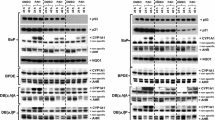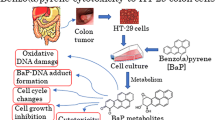Abstract
Polycyclic aromatic hydrocarbons (PAHs) are environmental pollutants. Some compounds belonging to this group are considered carcinogenic to people. In order to yield carcinogenic properties, these compounds must be metabolically transformed by enzymes of cytochrome P450 family to oxy-derivatives. In this study, the ability of the following six PAHs: anthracene (Ant), benz(a)anthracene (BA), naphthacene (Nap), benzo(a)pyrene (BaP), dibenz(a,c)anthracene (DB(a,c)A) and dibenz(a,h)anthracene (DB(a,h)A) to induce enzymes of cytochrome P450 (CYP450), in particular CYP1A1 and CYP1A2 in Mcf7 and HepG2 cells was studied. The induction of CYP1A enzymes was assessed at the level of enzymatic protein and enzymatic activity. The change in CYP1A1 and CYP1A2 protein level was assessed by means of confocal microscopy. The ethoxyresorufin-O-deethylase (EROD) and methoxyresorufin-O-deethylase (MROD) assays were applied to determine the CYP1A1 and CYP1A2 activity. The Induction Equivalency Factors (IEFs) were also determined. According to EROD and MROD assay and calculated IEFs the following order of the inducing potency was determined in HepG2 cells: DB(a,h)A > BaP > DB(a,c)A ≈ BA > Nap > Ant, and in Mcf7 cells: DB(a,h)A > DB(a,c)A > BaP > Nap > BA > Ant. The assessment of the protein levels revealed that DB(a,h)A was also the strongest inducer of protein level, however the correlation between enzymatic activity and protein level induction by other PAHs was not always evident. The EROD and MROD activities were higher in Mcf7 than in HepG2 cells, however the CYP1A2 protein level was shown to be higher in HepG2 cells. The results obtained indicate possible catalytic enzymatic activity alterations induced by PAHs.









Similar content being viewed by others
References
Alexandrie A-K, Warholm M, Carstensen U, Axmon A, Hagmar L, Levin JO, Ostman C, Rannung A (2000) CYP1A1 and GSTM1 polymorphisms affect urinary 1-hydroxypyrene levels after PAH exposure. Carcinogenesis 21:669–676
Arinc E, Sen A, Bozcaarmutlu A (2000) Cytochrome P4501A and associated mixed-function oxidase induction in fish as a biomarker for toxic carcinogenic pollutants in the aquatic environment. Pure Appl Chem 72:958–994
Baliharova V, Skalova L, Maas RFM, de Vrieze G, Bull S, Fink-Gremmels J (2003) The effects of benzimidazole anthelmintics on P4501A in rat Hepatocytes and HepG2 cells. Res Vet Sci 75: 61–69
Baum M, Amin S, Guengerich FP, Hecht SS, Kohl W, Eisenbrand G (2001) Metabolic activation of benzo[c]phenanthrene by cytochrome P450 enzymes in human liver and lung. Chem Res Toxicol 14:686–693
Berge G, Mollerup S, OVrebo S, Hewer A, Philips DH, Eilertsen E, Haugen A (2004) Role of estrogen receptor in regulation of polycyclic aromatic hydrocarbon activation in lung. Lung Cancer 45:289–297
Bols NC, Schirmer K, Joyce EM, Dixon DG, Greenberg BM, Whyte JJ (1999) Ability of polycyclic aromatic hydrocarbons to induce 7-ethoxyresorufin-o-deethylase activity in a trout liver cell line. Ecotoxicol Environ Saf 44:118–128
Bosveld AT, de Bie PA, van den Brink NW, Jongepier H, Klomp AV (2002) In vitro EROD induction equivalency factors for the 10 PAHs generally monitored in risk assessment studies in The Netherlands. Chemosphere 49:75–83
Boysen G, Hecht SS (2003) Analysis of DNA and protein adducts of benzo[a]pyrene in human tissues using structure-specific methods. Mutat Res 543:17–30
Bradford MM (1976) A rapid sensitive method for the quantitation of microgram quantities of protein utilizing the principle of protein-dye binding. Anal Biochem 72:248–254
Burke MD, Thompson S, Elcombre CR, Halpert J, Haaparanta T, Mayer RT (1985) Ethoxy-, pentoxy- and benzyloxyphenoxazones and homologues: a series of substrates to distinguish between different induced cytochromes P-450. Biochem Pharmacol 34:3337–3345
Chen G, Bunce NJ (2003) Polybrominated diphenyl ethers as a receptor agonists and antagonists. Toxicol Sci 76:310–320
Cook JW, Hewett CL, Hieger I (1933) The isolation of a cancer producing hydrocarbon from coal tar. J Chem Soc 1:395–405
Cronin MTD (2002) The current status and future applicability of quantitative structure-activity relationship (QSAR) in predicting toxicity. Altern Lab Anim 30:81–84
Dabestani R, Ivanov IN (1999) A compilation of physical, spectroscopic and photophysical properties of polycyclic aromatic hydrocarbons. Photochem Photobiol 70:10–34
Denizot F, Lang R (1986) Rapid colorimetric assay for cell growth and survival. J Immunol Methods 89:271–277
Falahatpisheh MH, Kerzee JK, Metz RP, Donnelly KC, Ramos KS (2004) Inducible cytochrome P450 activities in renal glomerular mesangial cells: biochemical basis for antagonistic interactions among nephrocarcinogenic polycyclic aromatic hydrocarbons. J Carcinog 3:12
Fent K, Batscher R (2000) Cytochrome P4501A induction potencies of polycyclic aromatic hydrocarbons in a fish Hepatoma cell line: demonstration of additive interactions. Environ Toxicol Chem 19:2047–2058
Fouchecourt MO, Arnold M, Berny P, Videmann B, Rether B, Riviere (1999) Assessment of the bioavailabilty of PAHs in rats exposed to a polluted soil by natural routes: induction of EROD activity and DNA adducts and PAH burden in both liver and lung. Environ Res 80:330–339
French CT, Hanneman WH, Chubb LS, Billings RE, Andersen ME (2004) Induction of CYP1A1 in primary rat Hepatocytes by 3,3′,4,4′,5-pentachlorobiphenyl: evidence of switch circuit element. Toxicol Sci 78:276–286
Garner RC (1998) The role of DNA adducts in chemical carcinogenesis. Mutat Res 402:67–75
Helma Ch, Kramer S, Pfahringer B, Gottmann E (2000) Data quality in predictive toxicology: identification of chemical structures and calculation of chemical properties. Environ Health Perspect 108:1029–1033
Huang Y-W, Stegeman JJ, Woodin BR, Karasov WH (2001) Immunohistochemical localization of cytochrome P4501A induced by 3,3′,4,4′,5-pentachlorobiphenyl (PCB126) in multiple organs of northern leopard frogs, rana pipens. Environ Toxicol Chem 20:191–197
Iba MM, Storch A, Ghosal A, Bennet S, Reuhl KR, Lowndes HE (2003) Constitutive and inducible levels of CYP1A1 and CYP1A2 in the rat cerebal cortex and cerebellum. Arch Toxicol 77:547–554
Iwanari M, Nakajima M, Kizu R, Hayakawa K, Yokoi T (2002) Induction of CYP1A1, CYP1A2 and CYP1B1 mRNAs by nitropolycyclic aromatic hydrocarbons in various human tissue-derived cells: chemical-, cytochrome P450 isoform-, and cell-specific differences. Arch Toxicol 76:287–298
Jerina DM, Lehr RE, Yagi H, Hernandez O, Dansette P, Wislocki PG, Wood AW, Chang RL, Levin W, Conney AH (1976) Mutagenicity of benzo(a)pyrene derivatives and the description of a quantum mechanical model which predicts the ease of carbonium ion formation from diol epoxides. In: deSerres FJ, Fouts JR, Bend JR, Philpot RM (eds) In vitro metabolic activation in mutagenesis testing. Elsevier/NorthHolland, Amsterdam, pp 159–176
Lehr RE, Jerina DM (1977) Relationships of quantum mechanical calculations, relative mutagenicity of benzo[a]anthracene diol epoxides, and “bay region” concept of aromatic hydrocarbon carcinogenicity. J Toxicol Environ Health 2:1259–1265
Li S, Yan X, Belanger A, Labrie F (1994) Prevention by dehydroepiandrosterone of the development of mammary carcinoma induced by 7,12-dimethylbenz(a)anthracene (DMBA) in the rat. Breast Cancer Res Treat 29: 203–217
Lloyd JW (1971) Long-term mortality study of steel workers: V. Respiratory cancer in coke plant workers. J Occup Med 13:53–68
Ma Q, Renzelli AJ, Kimberly T, Baldwin KT, Antonini JM (2000) Superinduction of CYP1A1 gene expression. J Biol Chem 275:12676–12683
Masson LF, Sharp L, Cotton SC, Little J (2005) Cytochrome P-450 1A1 gene polymorphisms and risk of breast cancer: a huge review. Am J Epidemiol 161:901–915
Mastral AM, Callen MS (2000) A review on polycyclic aromatic hydrocarbon (PAH) emission from energy generation. Environ Sci Technol 34:3051–3057
Miller JA (1998) The metabolism of xenobiotics to reactive electrophiles in chemical carcinogenesis and mutagenesis: a collaboration with Elizabeth Cavert Miller and our associates. Drug Metab Rev 30:645–674
Muller M, Voros J, Csucs G, Walter E, Danuser G, Textor M, Spencer ND (2003) Surface modification of PLGA microspheres. J Biomed Mater Res 66A:55–61
Musafia-Jeknic T, Mahadevan B, Pereira C, Baird WM (2005) Long term effects of a standarised complex mixture of urban dust particulate on the metabolic activation of carcinogenic polycyclic aromatic hydrocarbons in human cells in culture. Toxicol Sci 88:358–366
Neal J, Ridgon RH (1967) Gastric tumors in mice fed benzo(a)pyrene: a quantitative study. Tex Rep Biol Med 25:553–557
Nebert DW, Gelboin HV (1968) Substrate-inducible microsomal aryl hydroxylase in mammalian cell culture. J Biol Chem 243:6242–6249
Noguchi Y, Jungbluth A, Richards EC, Lloyd J. Old LY (1996) Effect of interleukin 12 on tumor induction by 3-methylcholanthrene. Proc Natl Acad Sci USA 93:11798–11801
Philips DH (1999) Polycyclic aromatic hydrocarbons in the diet. Mutat Res 443:139–147
Poland AP, Glover E (1974) Genetic expression of aryl hydrocarbon hydroxylase activity. J Biol Chem 249:5599–5606
Pott P (1963) Chirurgical observations relative to the cataract, polypus of the nose, the cancer of the scrotum, the different kinds of ruptures and the mortification of the toes and feet. Nat Cancer Inst Monogr 10:7–13
Roos PH, Tschirbs S, Welge P, Hack A, Theegarten D, Mogilevski G, Wilhelm M (2002) Induction of cytochrome P450 1A1 in multiple organs of minipigs after oral exposure to soils contamined with polycyclic aromatic hydrocarbons (PAH). Arch Toxicol 76:326–334
Schmitz H-J, Hagenmaier A, Hagenmaier H, Bock KW, Schrenk D (1995) Potency of mixtures of polychlorinated biphenyls as inducers of dioxin receptor-regulated CYP1A activity in rat Hepatocytes and H4IIE cells. Toxicol 99:47–54
Shimada T, Inoune K, Suzuki Y, Kawai T, Azuma E, Nakajima T, Shindo M, Kurose K, Sugie A, Yamagishi Y, Fujii-Kuriyama Y, Hashimoto M (2002) Arylhydrocarbon receptor-dependent induction of liver and lung cytochromes P450 1A1, 1A2 and 1B1 by polycyclic aromatic hydrocarbons and polychlorinated biphenyls in genetically engineered C57BL/6J mice. Carcinogenesis 23:1199–1207
Skupinska K, Zylm M, Misiewicz I, Kasprzycka-Guttman T (2006) Interaction of anthracene and its oxidative derivatives with human serum albumin. Acta Biochim Pol 53:101–12
Slaga TJ, Viaje A, Betty DL, Brachen W, Buty SG, Scribner JD (1976) Skin tumor initiating ability of benzo(a)pyrene 4,5- 7,5- and 7,8-diol-9,10-epoxides and 7,8-diol. Cancer Lett 2:115–121
Smith GBJ, Harper PA, Wong JMY, Lam MSM, Reid KR, Petsikas D, Massey TE (2001) Human lung microsomal cytochrome P4501A1 (CYP1A1) activities: Impact of smoking status and CYP1A1, aryl hydrocarbon receptor, and glutathione S-transferase M1 genetic polymorphisms. Cancer Epidemiol Biomarkers Prev 10:839–853
Snell KC, Stewart HL (1963) Induction of pulmonary adenomatoses in DBA/2 mice by the oral administration of dibenz[a,h]anthracene. Acta Unio Int Contra Cancrum 19:692–694
Till M, Riebniger D, Schmitz H-J, Schrenk D (1999) Potency of various polycyclic aromatic hydrocarbons as inducers of CYP1A1 in rat Hepatocyte cultures. Chem Biol Interact 117:135–150
Whitlock JJ (1999) Induction of cytochrome P4501A1. Annu Rev Pharmacol Toxicol 39:102–125
Wood AW, Levin W, Lu AY, Ryan D, West SB, Lehr RE, Schaefer-Ridder M, Jerina DM, Conney AH (1976) Mutagenicity of metabolically activated benzo[a]anthracene 3,4-dihydrodiol: evidence for bay region activation of carcinogenic polycyclic hydrocarbons. Biochem Biophys Res Commun 72:680–686
Xue W, Warshawsky D (2005) Metabolic activation of polycyclic and heterocyclic aromatic hydrocarbons and DNA damage: A review. Toxicol Appl Pharmacol 206:73–93
Yamagiwa K, Ichikawa K (1915) Experimentelle studie über die pathogenese der epithelialgeschwulste. Mitt Med Fak Tokio 15:295–344
Zacharova LY, Gulyaeva LF, Lyakhovich VV, Mikhailova ON, Timofeeva OA, Filipenko ML, Kaledin VI (2003) Cytochrome P4501A1 and 1A2 gene expression in the liver of 3-methylcholanthrene- and o-aminoazotoluene-treated mice: a comparision between PAH-responsive and PAH-nonresponsive strains. Toxicol Sci 73:108–113
ZhangK-L, Ma J-X, Chen X-Y, Sun Y, Kong Q-Y, Liu J, Li H (2004) Frequent CYP1A1 expression in gastric cancers and their related lesions. Oncol Rep 12:1335–1340
Author information
Authors and Affiliations
Corresponding author
Rights and permissions
About this article
Cite this article
Skupinska, K., Misiewicz, I. & Kasprzycka-Guttman, T. A comparison of the concentration–effect relationships of PAHs on CYP1A induction in HepG2 and Mcf7 cells. Arch Toxicol 81, 183–200 (2007). https://doi.org/10.1007/s00204-006-0140-y
Received:
Accepted:
Published:
Issue Date:
DOI: https://doi.org/10.1007/s00204-006-0140-y




